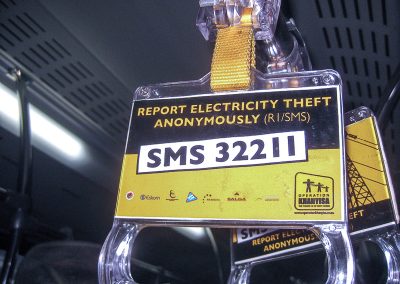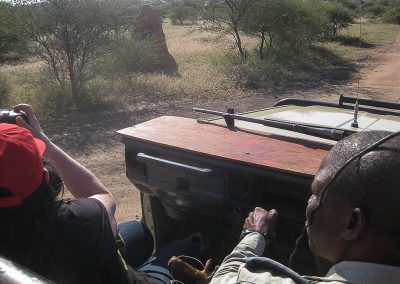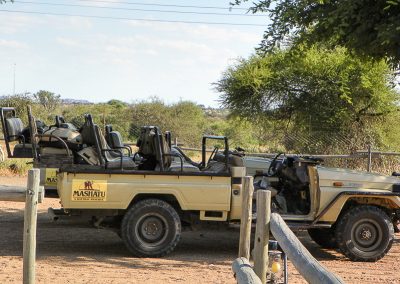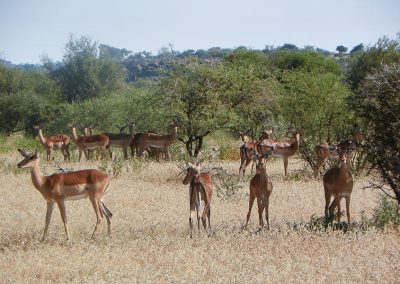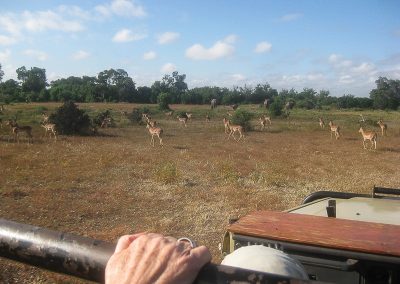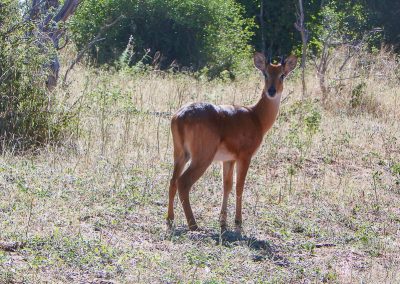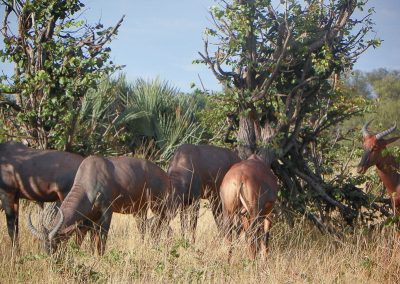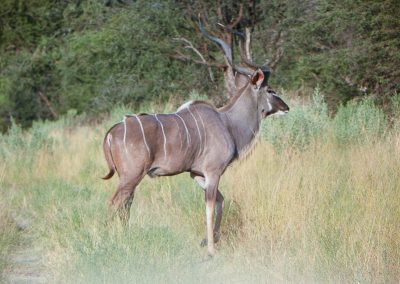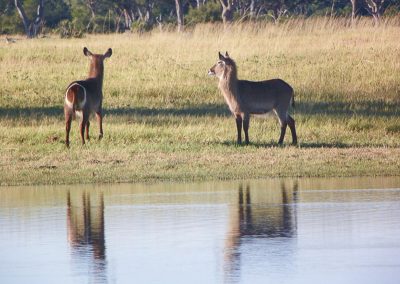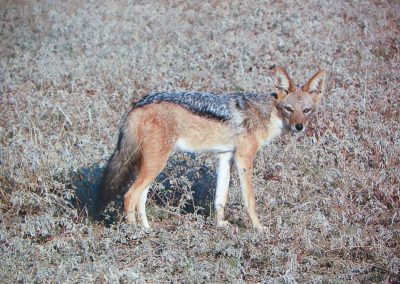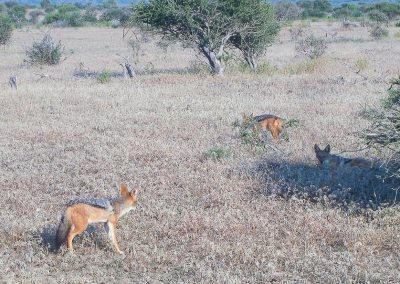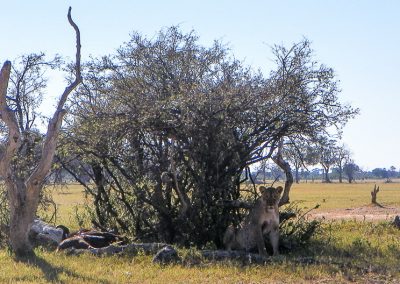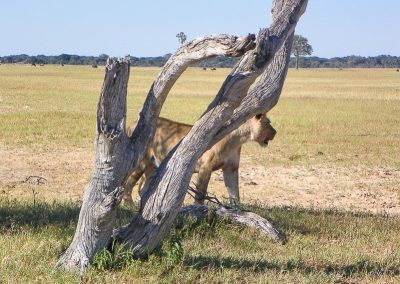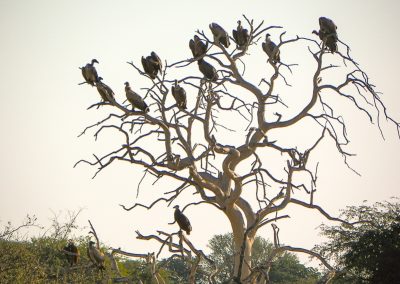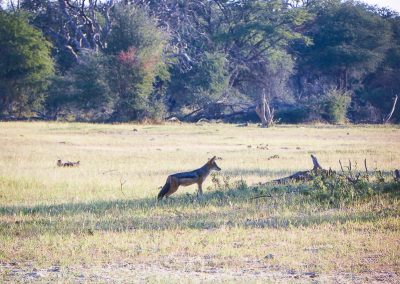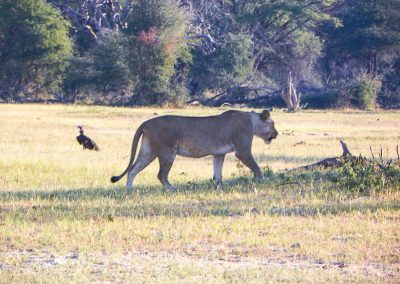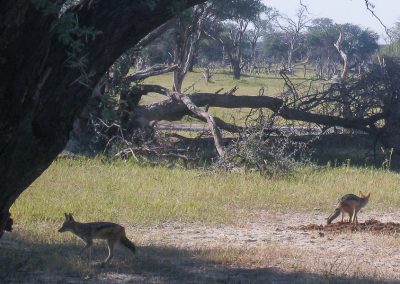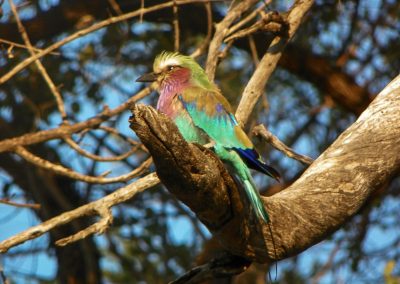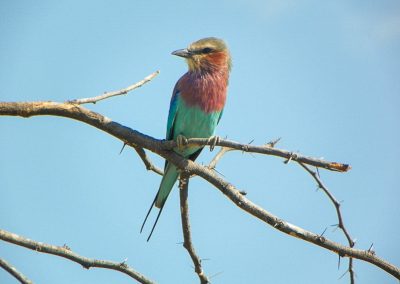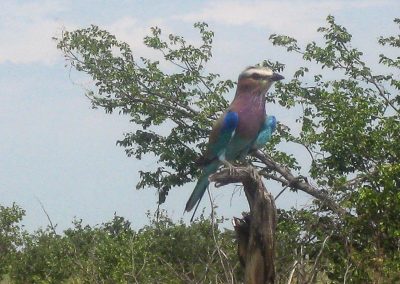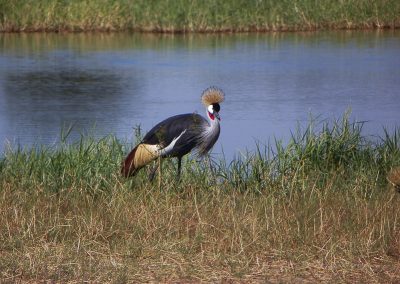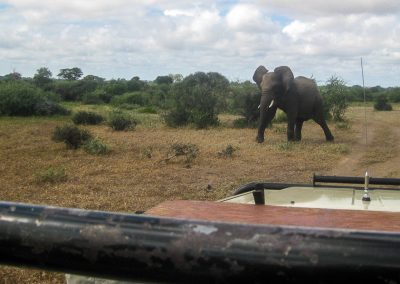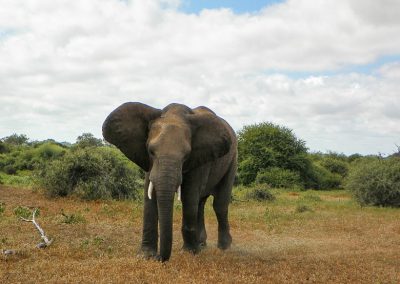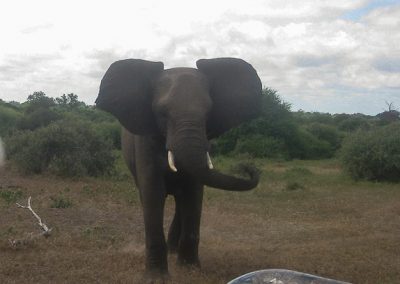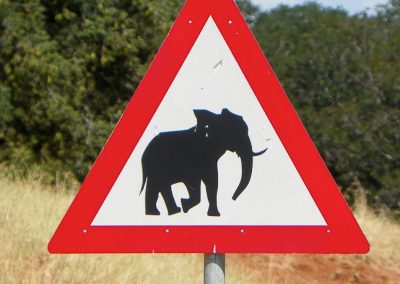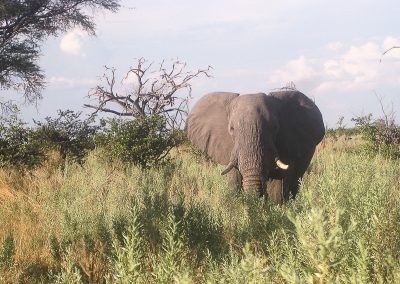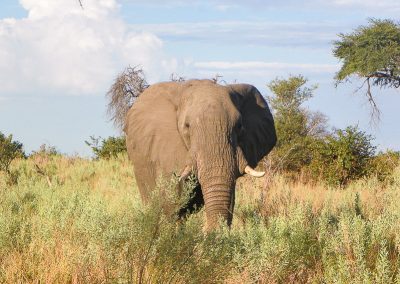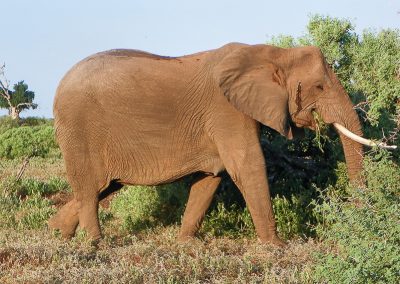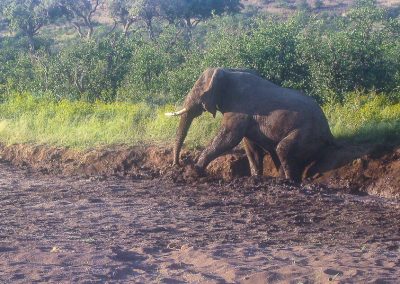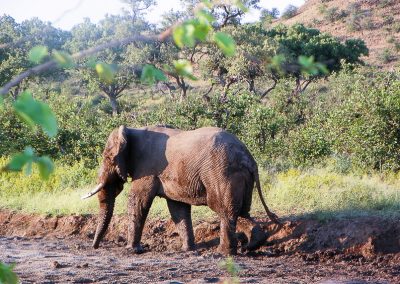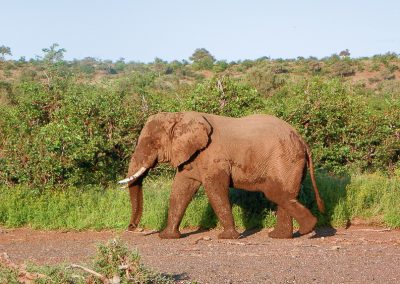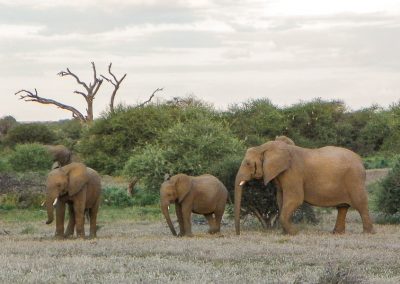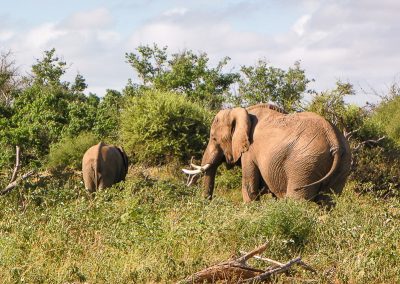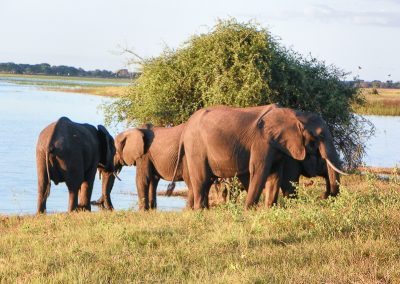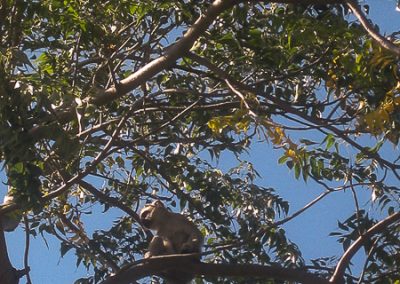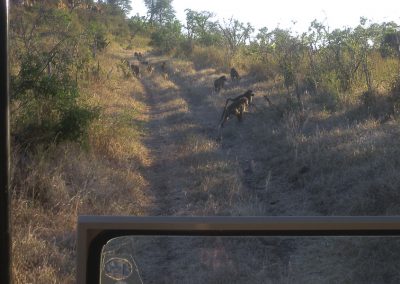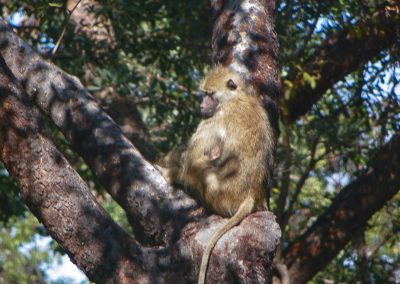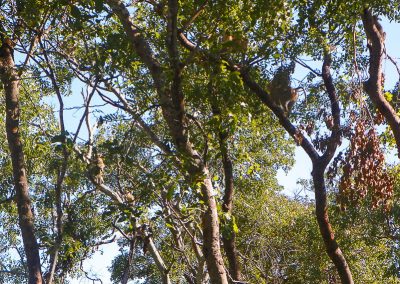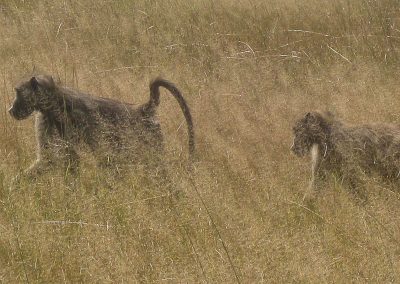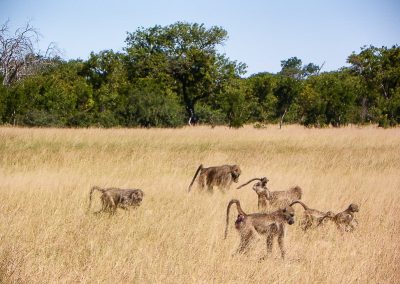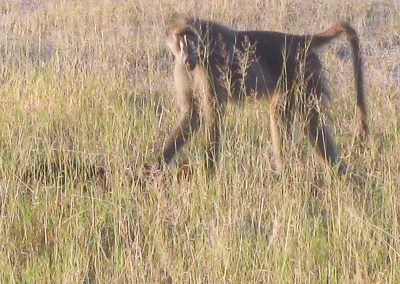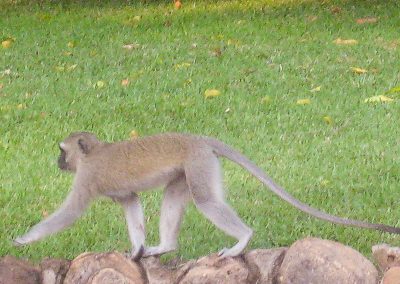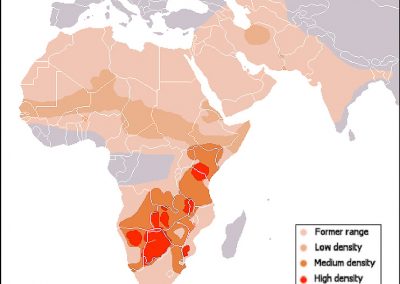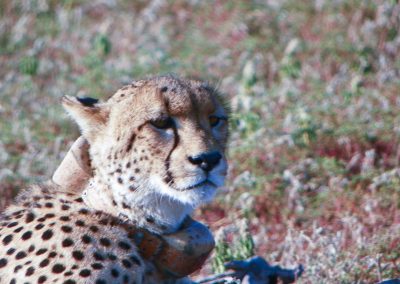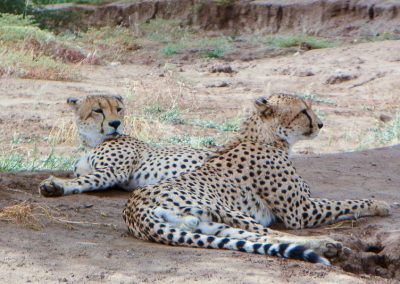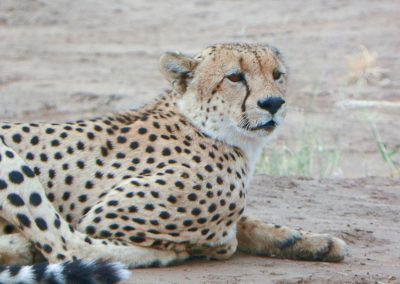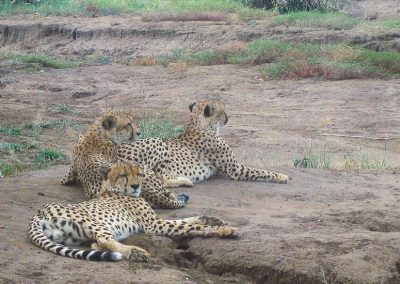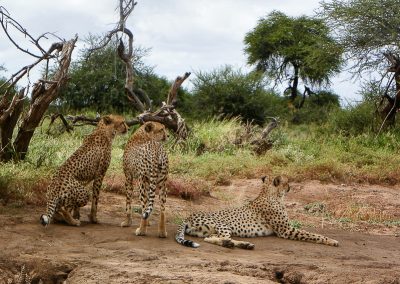
Africa – 2013
Getting There
The transportation getting to our first safari camp, Mashatu Botswana, was not simple, starting off with being at the Albuquerque airport at 4 am. Flights then continued to Washington DC, Dakar, Senegal and Johannesburg, South Africa. That night we stayed at the OR Tambo Protea Hotel near the airport, since we were flying out again in the morning. First photo is of the menu at the hotel, prices are in Rands. The official conversion rate was 9.3 Rands to the US dollar but the hotel only gave us 8 to the dollar. Had we spent more time in South Africa I would have questioned this practice but as jet lagged tourists we let it ride for one night. Pete ordered Springbok and baby rocket leaves. The springbok antelope was processed, rather like Canadian bacon and tasted good.
Africa – Getting There – 02
At the Johannesburg airport we took a shuttle from the plane to the building. This sign was displayed on the grab handles of the shuttle. Apparently there is a problem with hacking into electrical lines. Sounds quite dangerous to me.
Africa – Getting There – 03
The flight from Johannesburg to Polokwane, South Africa, on the northern border, was in a prop plane. The planes continue to get diminutive in size as we got deeper and deeper into the African bush. After landing in Polokwane it was a 2 hour drive to the Botswanan border. We crossed the Limpopo river. Rudyard Kipling popularized the Limpopo in his short story “The Elephant’s Child”, in which he described “the great grey-green, greasy Limpopo River, all set about with fever trees” where the “Bi-coloured Python Rock-Snake” dwells.
Africa – Getting There – 04
On the Botswana side of the border we were met by two guides with two Toyota Land Cruisers from Mashatu Private Game Reserve. Note the rifle mounted on the vehicle which was made in the Czech Republic.
Africa – Getting There – 05
I believe this is the last viewing we had of overhead power lines. Generators or solar power became the norm as the trip progressed. We stopped at a pavilion near a small air strip for a snack and ice tea. A sign asked pilots not to fly over the National Geographic web cam as the engine noise is deafening. Unfortunately the live feed from the web cam is down. I checked on it when we returned home. One more comment on the Toyota Land Cruisers….they are really tough awesome off road vehicles and so are the drivers! There are 14 people in our travel group, thus two vehicles.
Impala – Bottom of the Food Chain
Something has to be at the bottom of the food chain, and in the southern Africa realm of prey and predators the Impala is at the bottom. Through some quirk of nature Impalas are all born at the same time, allowing for some to be attacked/killed/eaten immediately but others survive. There didn’t seem to be a shortage of Impalas anywhere. They are even on the menu in some restaurants.
Africa – Impala – 01
Only the males have horns, so this is a Rank (herd) of females, with only one male laying claim to the ladies. He seems to spend his life guarding against the other bucks and chasing off the young males.
Africa – Impala – 02
You will notice in this Rank of Impalas they all have horns. These are the males who band together waiting for their opportunity to steal away a few of the girls. As the males travel together the guides called them The Boys Club or the Bachelor Herd. Yes, those are elephants in the background.
Africa – Impala – 03
This is a Steenbok. Their tails are not usually visible, only and inch or two long. They prefer to live in the savannah with no tendency to migrate to moister areas in the dry season. They browse on sunflowers, woody plants, roots and tubers.
Africa – Impala – 04
This one was new to me, not being familiar with the Tsessebe. When the guide noticed us struggling with the pronunciation and the spelling, he took out his game identification book. See the next photo. Tsessebe mark their territory by ground-horning, mud-packing, shoulder-wiping and grunting. The most important aggressive display of territorial dominance is in the horning of the ground. Another strange behavior is the habit of sleeping with their mouths down on the ground with the horns sticking straight up in the air.
Africa – Impala – 06
The Greater Kudu. We saw quite a few of these in small herds, although the correct term is a Cluster of Kudu. The horns do not begin to grow until the male is nearly a year old. It’s twists once at around 2 years of age and not reaching the full two and a half twists until they are 6 years old. This is one of the largest species of antelope, males weighing up to 600 lbs. The females are hornless.
Africa – Impala – 07
Waterbucks have waterproofing secretions in the sweat glands, producing an unpleasant odor in it’s meat. According to our guides waterbuck meat is not edible because it tastes bad, although it is safe to eat. Waterbucks take refuge in water to escape predators.
Africa – Impala – 08
Sable antelope. The females are the chestnut/dark brown color as in my photo. The males are black, with both genders having horns which can reach a meter in length. Very seldom during their fights for dominance do they inflict bodily harm to the contender. However, to defend themselves against lions, the horns have resulted in the death of many of the big cats. Unfortunately they have been hunted heavily because of the trophy horns.
Africa – Impala – 09
Eland antelope weigh between 1100 and 1500 lbs. It’s been domesticated in some areas and used for leather and it’s rich milk. The ones we saw were wild. The name “Eland” is the Dutch for elk or moose. Eland herds are accompanied by a loud clicking sound. It is speculated that the weight of the animal causes the two halves of it’s hooves to splay apart and the clicking is the result of the two halves snapping together when it lifts it’s leg. The sound carries some distance. We saw several other species of antelope like springboks and bushbucks. In fact at one camp three bushbucks walked within 2′ of our tent.
Jackals and the Lion Kill
Black-backed jackals are small, fox-like canids, weighing about 20 lbs. The camouflage of their coloring against the savannah grasses is so perfect that our guide had to point them out at first.
Africa – Lion Kill – 01
Black-backed jackals are monogamous and territorial, the older siblings helping to raise the pups. They are omnivores feeding on everything from beetles and grasshoppers to impalas and stealing the leftovers from lion kills.
Africa – Lion Kill – 02
The sounds made by black-backed jackals include yelling, yelping, woofing, whining, growling and cackling. They answer the calls of their pack but ignore those of strangers. They woof when startled and cackle like foxes when trapped.
Africa – Lion Kill – 03
We came across several jackals at the site of a lion kill. The lions brought down a Cape Buffalo, ate about half of it and left a single female to guard the rest of the carcass while the pride went to take a nap in the shade of some trees. Scenting the kill jackals and vultures started showing up to see what they could finish off. In this photo the jackal was looking directly at the lioness.
Africa – Lion Kill – 04
To the left of the lioness you can see the half eaten carcass of the buffalo. One horn tips off to the left. To the right of the lioness in the grass you can see the head of a jackal with his distinctive large ears. The lioness has blood on her mouth, chest and front legs. For as close as we were she seemed to know that the threat to her kill was not from the Toyota but from the scavengers.
Africa – Lion Kill – 05
So, as the jackals creep closer, she got up and snarled at them. One time we even saw her take off running to scare them back.
Africa – Lion Kill – 06
The vultures, in the meantime, were biding their time, waiting for their share of the remains from tree tops. This is only one of vulture trees. There must have been a half dozen with waiting birds. And some of the vultures were even standing on the ground.
Africa – Lion Kill – 07
Ever patient, the jackals started creeping back towards the carcass again. Considering the lioness was full and sleepy, we saw her nod off, closing her eyes a few times. I suspect the jackals knew she was sleepy too.
Africa – Lion Kill – 08
After the brief chase, the lioness returned to her kill. Here is a vulture waiting his turn also.
Africa – Lion Kill – 09
On another day, we found the jackals on a dung pile, and from the size of it I’ll assume it was elephant. 40% of the elephant vegetable matter is not digested, so the jackals are eating it.
Birds
Our guides commented several times that the Lilac-breasted Rollers are the most photographed birds in all of Africa. The range of colors is outstanding. The average size of the Lilac Breasted Roller is 15 inches. The washed green head is large, the neck is short, the greenish yellow legs are rather short and the feet are small. The beak is strong, arched and hooked-tipped. The tail is narrow and of medium length. The back and scapulars are brown. The shoulder of the wing, outer webs of the flight feathers and the rump are all violet. The bases of the primaries and their coverts are pale greenish blue and the outer tail feathers are elongated and blackish. The chin is whitish, shading to rich lilac of the breast. The underparts are greenish blue. The bill is black and the eyes are brown. It has large wings and strong flight.
Africa – Birds – 01
Lilac-breasted Rollers were so common we saw them nearly every day, across four countries. And even after taking a multitude of photographs, they were still so outstanding that we wanted to take even more.
Africa – Birds – 02
Rollers get their name from their impressive courtship flight, a fast, shallow dive from considerable elevation with a rolling or fast rocking motion, accompanied by loud raucous calls. Their call is a loud harsh squawk, ‘zaaak’. All rollers appear to be monogamous and highly territorial. The Lilac Breasted Roller will perch on a dead tree, surveying the area for prey (lizards, scorpions, snakes, rodents). One typical aspect of its behavior is that it also preys on animals fleeing from bush fires. It is a swift flier, indulging in acrobatics during the breeding season. They actually breed ‘on the wing’. The male climbs to about 150′ and then dives with closed wings at great speed, repeatedly rolling from side to side in latter part of descent, landing next to the female. We did see them flying but I was unable to catch them on the camera.
Africa – Birds – 03
The sexes are alike in coloration. Juveniles do not have the long tail feathers that adults do. It is also the national bird of Botswana and Kenya.
Africa – Birds – 04
The Grey Crowned Crested Crane is found from the Congo down to South Africa. Their global population is estimated between 55,000 and 75,000. In 2012 it was uplisted from Vulnerable to Endangered by the IUCN. It’s also the national bird of Uganda. This species and the closely related black cranes are the only cranes that can roost in trees because of a long hind toe that can grasp branches. It’s over 3′ tall with a wingspan of six and a half feet. The head has stiff golden feathers. They are omnivores eating grains, seeds, insects, frogs, worms snakes, eggs, and small fish. They stamp their feet when they walk to flush out insects which are quickly caught and eaten.
Elephants
Of all the wildlife we saw, my personal favorites were the young male elephants. They were so animated, so full of themselves, showing off their bravery, quite a show of extra testosterone! They would come charging out of the bush, trunks arching, loud trumpeting, foot stamping, ears flapping and posturing for all they were worth! They’d come up close to our vehicles before stopping but the guides reassured us that it’s all for showing off. These boys were small compared to the more mature elephants. Elephants continue to grow their entire lives, although the growth rate slows after sexual maturity. If only I could have captured the trumpeting to go along with these photos. Here is a clip on YouTube that will give you an idea of the audio.
Regarding the quality of the photos….our game drives were very early morning and dusk as the animals rest during the day and are far less active. Unfortunately the sun didn’t always cooperate.
Africa – Elephants – 01
Among these photos of the charging boys I’m going to write about the necessity for mature bulls to keep the youngsters in line. The story comes from Kruger National Park, South Africa.
Africa – Elephants – 02
Some years ago, officials at the Kruger National Park and game reserve in South Africa were faced with a growing elephant problem. The population of African elephants, once endangered, had grown larger than the park could sustain. So measures had to be taken to thin the ranks. A plan was devised to relocate some of the elephants to other African game reserves. Being enormous creatures, elephants are not easily transported. So a special harness was created to air-lift the elephants and fly them out of the park using helicopters. The helicopters were up to the task, but, as it turned out, the harness wasn’t. It could handle the juvenile and adult female elephants, but not the huge African bull elephants. A quick solution had to be found, so a decision was made to leave the much larger bulls at Kruger and relocate only some of the female elephants and juvenile males.
Africa – Elephants – 03
The problem was solved. The herd was thinned out, and all was well at Kruger National Park. Sometime later, however, a strange problem surfaced at South Africa’s other game reserve, Pilanesburg National Park, the younger elephants’ new home. Rangers at Pilanesburg began finding the dead bodies of endangered white rhinoceros. At first, poachers were suspected, but the huge rhinos had not died of gunshot wounds, and their precious horns were left intact. The rhinos appeared to be killed violently, with deep puncture wounds. Not much in the wild can kill a rhino, so rangers set up hidden cameras throughout the park.
Africa – Elephants – 04
The result was shocking. The culprits turned out to be marauding bands of aggressive juvenile male elephants, the very elephants relocated from Kruger National Park a few years earlier. The young males were caught on camera chasing down the rhinos, knocking them over, and stomping and goring them to death with their tusks. The juvenile elephants were terrorizing other animals in the park as well. Such behavior was very rare among elephants. Something had gone terribly wrong.
Africa – Elephants – 05
Some of the park rangers settled on a theory. What had been missing from the relocated herd was the presence of the large dominant bulls that remained at Kruger. In natural circumstances, the adult bulls provide modeling behaviors for younger elephants, keeping them in line.
Africa – Elephants – 06
To test the theory, the rangers constructed a bigger and stronger harness, then flew in some of the older bulls left behind at Kruger. Within weeks, the bizarre and violent behavior of the juvenile elephants stopped completely. The older bulls let them know that their behaviors were not elephant-like at all. In a short time, the younger elephants were following the older and more dominant bulls around while learning how to be elephants.
Africa – Elephants – 08
As many as 27 million (estimated wild population) elephants lived in Africa in the 19th century; in 2002, only 400,000 – 660,000. The decline can be linked to three major factors: (1) the demand for ivory, (2) desertification, and (3) conflicts with humans for land use. From 1860 to 1930, 25,000 to 100,000 elephants were killed for their ivory each year. It’s truly a heartbreaking reality to me. And the slaughter goes on. It’s illegal to import ivory into the US.
Africa – Elephants – 09
We came across a dry river bed with this elephant trying to find some remaining mud for a mud bath. Elephants do not sweat. Mud baths serve a critical purpose for elephants. Under the harsh, African sun the heat and UV radiation can be deadly. Romping around in mud not only cools them down, but provides a protective layer to shield their body from the sun’s rays. Since elephant hair is fairly sparse on their bodies, they actually can get sunburnt; especially young elephants with sensitive skin.
Africa – Elephants – 10
Elephants are voracious feeders and can spend up to 16 – 18 hours a day consuming grass, tender shoots and bark from trees. Only 60% is digested, the remaining 40% goes through the system with nutrients intact. An adult elephant eats over 350 lbs of vegetation each day. An adult elephant can drink up to 53 gallons of water in a single session. All this eating and drinking means that a single elephant deposits upwards of 300 lbs. of dung every day – about one dollop every 15 minutes!
Africa – Elephants – 11
Although today there are only two living species in the elephant family, there used to be some 150 species. Elephants are extremely intelligent animals and have memories that span many years. It is this memory that serves matriarchs well during dry seasons when they need to guide their herds, sometimes for tens of miles, to watering holes that they remember from the past. They also display signs of grief, joy, anger and play.
Africa – Elephants – 12
Recent discoveries have shown that elephants can communicate over long distances by producing a sub-sonic rumble that can travel over the ground faster than sound through air. Other elephants receive the messages through the sensitive skin on their feet and trunks. It is believed that this is how potential mates and social groups communicate. The ear drums can only record a certain pitch range, but apparently the deep sub-sonic rumble is transferred through the elephant’s feet and other tympanic membranes. Sound is feeling. That’s what it comes down to. When sounds go low enough, we can’t hear them anymore: we can only feel them. This works for elephants too.
Africa – Elephants – 13
Our guides were certainly cautious of mothers with young and we stayed at a respectful distance.
Baboons
The parts of southern Africa we visited included three types of primates.
Bush Baby, characterized by it’s loud shrill cries at night similar to a human baby, are nocturnal with large eyes and bat-like ears enable them to hunt insect prey at night. They are very agile in trees but awkward on the ground, hopping in a frog like fashion. During the day they hide to avoid eagles and large snakes.
The first day we arrived at Mashatu, Botswana we were visited by Vervet monkeys by our tent. Vervet monkeys are long-legged, long-tailed, omnivorous. Every time Pete walked out of our tent to take a photo the Vervets scurried off.
Mostly we saw Baboons. There were two species, the smaller Yellow Baboons and the larger Chacma Baboons. They traveled in troops, sometimes with 50-100 or more members.
Africa – Baboons – 01
The first day we arrived at Mashatu, Botswana we were visited by Vervet monkeys by our tent. Vervet monkeys are long-legged, long-tailed, omnivorous. Every time Pete walked out of our tent to take a photo the Vervets scurried off. Eventually he succeeded with this photo.
Africa – Baboons – 02
Baboon society is a strictly disciplined one. Each member of the troop knows his status and ruled over by an elite group of elders. Any member of the clan who tries to usurp another’s position is taken to task by the dominant males who gang up against the offender resulting in an explosion of screaming and squawking. The degree of dominance among ruling members of the clan is shown by the angle at which they hold their tails: the higher the angle, the more dominant the male.
Africa – Baboons – 03
Baboons are fierce fighters and in a group can confront and scare off predators such as leopard. Males may confront predators like leopards or cheetahs by forming a line and strutting in a threatening manner while baring their large canines and screaming.
Africa – Baboons – 04
Baboons use many vocalizations ranging from grunts to barks to screams. Non vocal gestures include yawns, lip smacking and shoulder shrugging. We stopped to watch the youngsters running, chasing, climbing and having the time of their life having fun.
Africa – Baboons – 05
When we first arrived at the safari camps it was explained to us that laundry service was available each day by the staff. However, cultural taboos prohibited the staff from doing our underwear, called “Tinies” or “Tinys”. Therefore, we were in charge of washing out the Tinys ourselves in the bathroom sink, wringing them out in a towel and hanging up to dry in the corner of our tents. We were warned in all five camps not to hang laundry outside as the baboons were quite likely to steal them off the line. The curious and playful baboons will also attempt to wear your undergarments, frequently putting your Tinys on their heads. No one in our group tested these warnings, we all dried the Tinys indoors.
Africa – Baboons – 06
In this troop, a baby is catching a ride on the back of Mom. Mating is frequent at very short bursts usually only about 15 – 20 seconds. They breed at any time of the year and their gestation period is about 6 months. The basic unit is a harem – one dominant male surrounding himself with a number of breeding females.
Africa – Baboons – 07
Baboons use at least 10 different vocalizations to communicate. When traveling as a group, males will lead, females and the young stay safe in the middle, and less-dominant males bring up the rear. A baboon group’s hierarchy is such a serious matter, some subspecies have developed interesting behaviors intended to avoid confrontation and retaliation. For example, males have frequently been documented using infants as a kind of “passport” for safe approach toward another male. One male will pick up the infant and hold it up as it nears the other male. This action often calms the approached male and allows the former male to approach safely.
Africa – Baboons – 08
This Vervet monkey Pete photographed in the parking lot of the hotel in Victoria Falls. The five distinct subspecies can be found mostly throughout Southern Africa, as well as some of the eastern countries. Vervets were transported to the islands of Barbados, Saint Kitts and Nevis Islands in the Caribbean in conjunction with the African slave trade.
Cheetahs
We were incredibly fortunate to visit locations in southern Africa where there is a high density of cheetahs in the wild. Cheetahs are probably best known for their short bursts of speed up to 75 mph for distances up to a half mile. They can also accelerate from 0 to 60 mph in 5 seconds.
Cheetahs are also known for their non-retractable claws, although our guide mentioned that cubs up until the age of 3 or 4 months CAN retract their claws.
Africa – Cheetahs – 01
We were incredibly fortunate to visit locations in southern Africa where there is a high density of cheetahs in the wild, indicated by the large dark orange areas on the map.
Africa – Cheetahs – 02
Cheetahs are probably best known for their short bursts of speed up to 75 mph for distances up to a half mile. They can also accelerate from 0 to 60 mph in 5 seconds. Cheetahs are also known for their non-retractable claws, although our guide mentioned that cubs up until the age of 3 or 4 months CAN retract their claws. This female lounging in the sun was the first cheetah we saw, and she was wearing a tracking collar. I was surprised at the size of the collar as you can see better on the second photo.
Africa – Cheetahs – 03
Cheetahs have an unusually low genetic variability and a low sperm count. Skin grafts between unrelated cheetahs are not rejected. Recent DNA analysis has shown some similar markers making it the closest living relative of the North American cougar/puma–jaguar. The separation was around 5 million years ago. Adult cheetahs can weigh up to 160 lbs.
Africa – Cheetahs – 04
Unlike true big cats the cheetah can purr as it inhales, but cannot roar. By contrast, the big cats can roar but cannot purr, except while exhaling. The cheetah is still considered by some to be the smallest of the big cats. While it is often mistaken for the leopard, the cheetah does have distinguishing features, such as the long “tear-streak” lines that run from the corners of its eyes to its mouth, and spots that are not “rosettes”. The thinner body frame of the cheetah is also very different from that of the leopard. We came across three cheetah brothers resting in the morning sun. Aside from the occasional glance towards our vehicle they proved to be far more interested in distant sights and sounds. We were very close, within 40′ of them. Our guide said these brothers always hunt together.
Africa – Cheetahs – 05
Cheetahs hunt usually either early in the morning or later in the evening when it is not so hot, but there is still enough light. The cheetah hunts by vision rather than by scent. Prey is stalked to within 30-100′, then chased. This is usually over in less than a minute, and if the cheetah fails to make a catch quickly, it will give up. The cheetah has an average hunting success rate of around 50%. Running at very high speeds puts a great deal of strain on the cheetah’s body. When sprinting, the body temperature quickly elevates. If it is a hard chase, it sometimes needs to rest for half an hour or more. The cheetah kills its prey by tripping it during the chase, then biting it on the underside of the throat to suffocate it; the cheetah is not strong enough to break the necks of most prey. The bite may also puncture a vital artery in the neck. Then the cheetah proceeds to devour its catch as quickly as possible before the kill is taken by stronger predators. Our guide mentioned that hyenas are the biggest threat. When cheetahs are outnumbered by hyenas they lose their kill.
Africa – Cheetahs – 06
We flew into a dirt landing strip to a game park in Botswana and within 5 minutes our guide spotted two cheetahs in tall grass under a tree. I didn’t see it at all until given specific directions as to where to look. They have a distinctive spotted coat which allows it to blend easily into high, dry grasses. Cheetahs need only drink once every three to four days.
Africa – Cheetahs – 07
Female cheetahs typically have a litter of three cubs and live with them for one and a half to two years. Young cubs spend their first year learning from their mother and practicing hunting techniques with playful games. Male cheetahs live alone or in small groups, often with their littermates.
(505) 672-9562
Petr Jandacek
Louise Jandacek
Mailing Address
127 La Senda Road
Los Alamos, New Mexico
USA
87544

